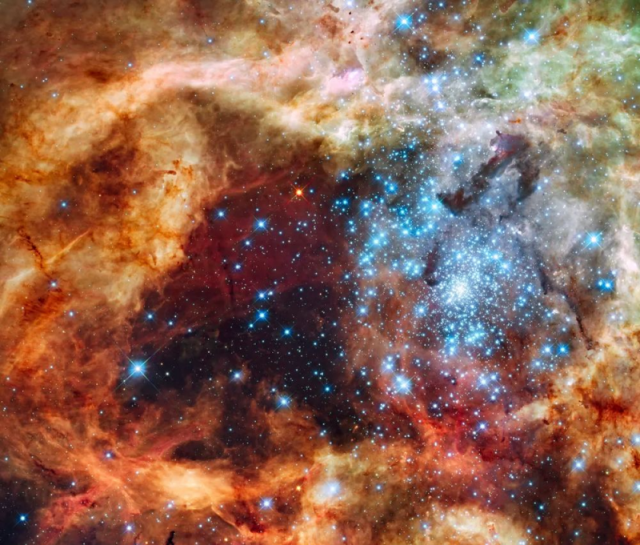Home >
Announcement
Announcement
ISSI-BJ Workshop | Space-based Stellar Astrophysics in the Ultraviolet
14-18 April 2025, Beijing
Editor: | Jan 22 , 2025

Credits: NASA, ESA, STScI, Francesco Paresce (INAF-IASF Bologna), Robert O'Connell (UVA), SOC-WFC3, ESO
Context
Astronomical 'fashions' tend to go through cycles. For quite some time now, much of the focus of the international astronomical community has been on questions related to the origin and evolution of the universe at large, and of the galaxies within it. Stellar astrophysics has, to some extent, been relegated to the back seat. However, armed with new insights about the intricacies of the processes of star formation and stellar evolution, for a large range of stellar masses and specifically beyond the nominal main-sequence stage, stellar astrophysics is slowly making its way back to the forefront of modern astrophysics. New insights into solar physics at ultraviolet wavelengths similarly continue apace. Recent effort in astronomical instrumentation has been focused on red and infrared capabilities, with research at the blue and ultraviolet end of the spectrum somewhat underdeveloped. However, there is now significant activity within the remits of various space agencies aimed at redressing this imbalance.
In the local Universe, where we can resolve both the Sun and individual stars, and explore the physics of star formation in exquisite spatial detail, the blue and (ultra)violet wavelength range is where most of the action occurs. Therefore, we propose to bring together experts from a wide range of stellar astrophysics backgrounds to discuss the state of the art in the field of "space-based stellar astrophysics in the ultraviolet". The ultraviolet wavelength range, best or only accessible from space (depending on one's precise wavelength range), holds the key to understanding the details of the star-formation process—of course in combination with infrared observations allowing us to peer through the ubiquitous circumstellar dust.
This is also the range, particularly at near-ultraviolet wavelengths also accessible from the ground, where we can best understand and study the nucleosynthetic origin of the iron-peak elements, molecules and neutron-capture elements. The ultraviolet offers a wealth of unique information and direct access to activity indicators in stellar atmospheres (e.g., in the form of chromospheric variability in solar-mass or more massive stars) and the stellar environment. That latter aspect, in relation to the high energies represented by ultraviolet emission, links directly to the conditions for habitability on exoplanets in those immediate stellar environments, both in the general galactic field and in star clusters.
We aim to focus on recent and current highlights from a diversity of ongoing ultraviolet missions, including the Hubble Space Telescope/HST, India's ASTROSAT/UVIT and Aditya-L1, the Optical Monitor on XMM-Newton, Japan's Solar-C and UVOT on Swift, while providing recommendations for future synergies between ultraviolet capabilities and longer-wavelength missions. This is an opportune time to organize such a workshop, given the increasing focus on ultraviolet science worldwide. In Europe, the NUVA network has built a community to promote future missions. The International Astronomical Union (IAU) hosts an ultraviolet astronomy Working Group within Division B, which has promoted the IAU resolution to set standards in ultraviolet photometry in preparation for future missions. A range of future ultraviolet missions are now in the planning or development phases, including China's Space Station Telescope (a wider-field, Hubble Space Telescope-like observatory which will include UV capabilities), CASTOR (Canada, UK), UVEX (USA), ULTRASAT (Israel, USA), SIRIUS[1] (UK) and ESCAPE (USA). On a longer timescale, NASA has adopted the UV/Optical/IR Habitable Worlds Observatory/HWO as its next flagship, to be developed with international partners. Our aim is to not only gain a comprehensive understanding of a wide range of aspects pertaining to stellar physics that are only accessible at the shortest wavelengths, but to also and ultimately define a roadmap that should stand the test of time in the near term and form the basis for near-future developments in this newly re-emerging field.
To aid with the delivery of our main aims, this ISSI-BJ workshop will cover the six key topics highlighted in Section 3 in sessions of at least 3 hours each, led by some of the key scientists driving these fields (many of whom are among our proposed conveners). Where possible and appropriate, we will give the junior scientists responsible for most of the ground work a prominent role in the meeting’s program, in essence to set them up as future leaders with links to the 'movers and shakers' in this area internationally. In addition to their integral role in the main meeting program, we will also set aside a specific session focusing entirely on the science driven by the young scientists.
Objectives
- The Sun at ultraviolet wavelengths
- Stellar atmospheres
- Stellar environments (including the impact on exoplanets in the habitable zone)
- Stellar activity (transients, flares, coronal mass ejections and winds)
- Star clusters
- Synergies with modern ground-based and space-borne observatories
Product
Following the workshop, Springer will publish its output as a volume in the Space Science Series of ISSI. The objectives of the book are:
- Stellar astrophysics in the ultraviolet: Setting the scene
- The Sun and stellar nucleosynthesis at ultraviolet wavelengths
- Accretion and outflows in the ultraviolet
- Ultraviolet radiation fields in stellar environments
- Transients and stellar activity as revealed by ultraviolet diagnostic tracers
- Star clusters in the ultraviolet
- The impact of UV radiation on astrobiology
- Synergies with modern UV ground-based and space-borne observatories
Convenors
| Martin Barstow | Leicester University, UK |
| Pengfei Chen | Nanjing University, China |
| Richard de Grijs (Chair) | Macquarie University, Australia / International Space Science Institute-Beijing, China |
| Ana I. Gomez de Castro | Complutense University of Madrid, Spain |
| Li Ji | Purple Mountain Observatory, Chinese Academy of Sciences, China |
| Chao Liu | National Astronomical Observatories, Chinese Academy of Sciences,China |
| Annapurni Subramaniam | Indian Institute of Astrophysics Bangalore, India |
Download:


